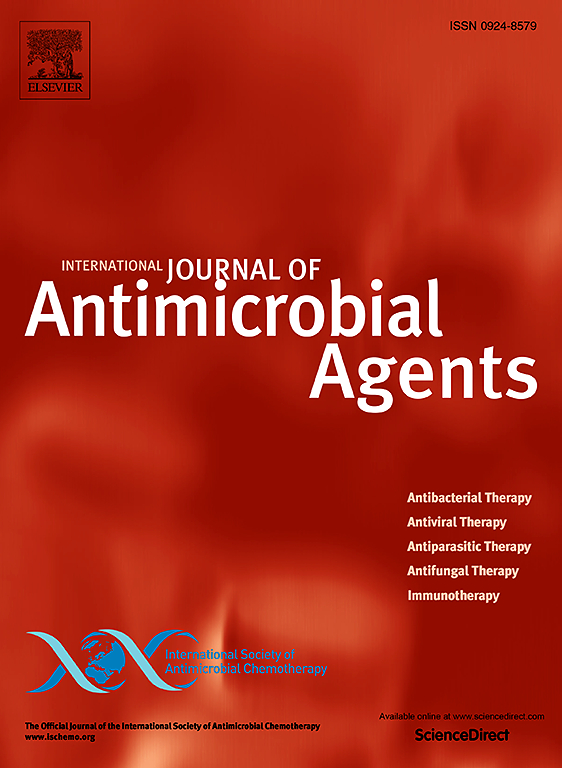Geographic variations in distributions of carbapenemase-encoding genes, susceptibilities, and minimum inhibitory concentrations of inpatient meropenem-resistant Enterobacterales to ceftazidime-avibactam, meropenem-vaborbactam, and aztreonam-avibactam across four global regions: 2020–2022 data from the Antimicrobial Testing Leadership and Surveillance
IF 4.9
2区 医学
Q1 INFECTIOUS DISEASES
International Journal of Antimicrobial Agents
Pub Date : 2025-03-31
DOI:10.1016/j.ijantimicag.2025.107500
引用次数: 0
Abstract
Purpose
To evaluate the susceptibility profiles of regional inpatient meropenem-resistant (MEM-R) carbapenemase-producing Enterobacterales (CPE) isolates and their MIC values to ceftazidime-avibactam (CZA), meropenem-vaborbactam (MVB), and aztreonam-avibactam (ATM-AVI)
Methods
The 2020–2022 Antimicrobial Testing Leadership and Surveillance database were analyzed. Carbapenemase-encoding genes in CPE isolates were identified using multiplex PCR and Sanger sequencing. Susceptibility breakpoints for CZA and MVB recommended by CLSI 2024 and EUCAST 2025 against Enterobacterales were applied.
Results
A total of 2,318 CPE isolates (78.2% were Klebsiella pneumoniae) were tested globally. Notable diversity in carbapenemase-encoding gene distributions was observed among CPE isolates from Africa/the Middle East (10 countries; n=361), Asia (7 countries, excluding India and Pakistan; n=182), Europe (17 countries; n=1,002), and Latin America (10 countries; n=773). Metallo-β-lactamase-encoding genes, predominantly blaNDM-1, were more frequently detected in CPE isolates from Africa/the Middle East (75.3%, except blaNDM-5 in Kuwait) and Asia (67%, except blaIMP-8 in Taiwan) compared to other regions. Among KPC variants, the KPC-2 enzyme was the predominant one in CPE isolates in Europe (43.4%, except for KPC-3 prevalent specifically in Italy) and in Latin America (62.1%). The susceptibility rates of all analyzed CPE isolates harboring only a single blaKPC gene to CZA and MVB were 99.4% and 93.5%, respectively, based on the CLSI 2024 susceptibility breakpoints. The MIC50/90 values of CPE isolates to ATM-AVI were 0.12/0.25 mg/L and 0.5/1 mg/L, respectively, regardless of collection region, dual carbapenemase production, or infection source.
Conclusions
The trends in resistance to novel antibiotics among contemporary CPE isolates need close monitoring.

碳青霉烯酶编码基因分布的地理差异、对美罗培南耐药肠杆菌对头孢他啶-阿维巴坦、美罗培南-瓦波巴坦和氮曲南-阿维巴坦的敏感性和最低抑制浓度:2020-2022年全球四个地区的抗菌测试领导和监测数据
为了评估地区住院患者耐美罗培烯(memr)产碳青霉烯酶肠杆菌(CPE)分离株对头孢他啶-阿维巴坦(CZA)、美罗培烯-瓦博巴坦(MVB)和氮曲南-阿维巴坦(ATM-AVI)的敏感性及其MIC值,我们分析了2020-2022年抗菌检测领导和监测数据。利用多重PCR和Sanger测序技术对CPE分离株碳青霉烯酶编码基因进行了鉴定。采用CLSI 2024和EUCAST 2025推荐的CZA和MVB对肠杆菌的药敏断点。全球共检测了2318株CPE分离株(78.2%为肺炎克雷伯菌)。碳青霉烯酶编码基因分布在非洲/中东(10个国家;n=361),亚洲(7个国家,不包括印度和巴基斯坦;n=182),欧洲(17个国家;n= 1002),拉丁美洲(10个国家;n = 773)。与其他地区相比,金属β-内酰胺酶编码基因主要为blaNDM-1,在非洲/中东(75.3%,科威特除外blaNDM-5)和亚洲(67%,台湾除外blandm -8)的CPE分离株中检出频率更高。在KPC变体中,KPC-2酶在欧洲(43.4%)和拉丁美洲(62.1%)的CPE分离株中占主导地位,除了意大利流行的KPC-3酶外。基于CLSI 2024敏感性断点,所有仅含单一blaKPC基因的CPE分离株对CZA和MVB的易感性分别为99.4%和93.5%。CPE分离株对ATM-AVI的MIC50/90值分别为0.12/0.25 mg/L和0.5/1 mg/L,与采集区、双碳青霉烯酶产生和感染源无关。当代CPE分离株对新型抗生素耐药的趋势需要密切监测。
本文章由计算机程序翻译,如有差异,请以英文原文为准。
求助全文
约1分钟内获得全文
求助全文
来源期刊
CiteScore
21.60
自引率
0.90%
发文量
176
审稿时长
36 days
期刊介绍:
The International Journal of Antimicrobial Agents is a peer-reviewed publication offering comprehensive and current reference information on the physical, pharmacological, in vitro, and clinical properties of individual antimicrobial agents, covering antiviral, antiparasitic, antibacterial, and antifungal agents. The journal not only communicates new trends and developments through authoritative review articles but also addresses the critical issue of antimicrobial resistance, both in hospital and community settings. Published content includes solicited reviews by leading experts and high-quality original research papers in the specified fields.

 求助内容:
求助内容: 应助结果提醒方式:
应助结果提醒方式:


